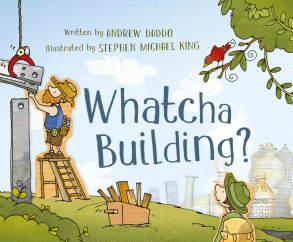
Whatcha Building?
Whatcha Building?
Andrew Daddo
Stephen Michael King
ABC Books, 2017
32pp, hbk., RRP $A24.99
9780733334153
Every day on his way home from school Little Davey Durak watches the old milk bar on the corner being demolished, another victim of the ever-encroaching city inexorably guzzling all in its path. And every day Bruce the Builder would say hello to Davey as he carefully pulled the building apart and put the pieces in the skip, their final resting place.
One afternoon, Davey asks Bruce for some wood -something he begins to do each day. Sometimes it is a long piece and sometimes, short or chunky or thin. But no matter how often Bruce asks what Davey is building, Davey doesn’t tell. Bruce has heaps of ideas about what it could be but Davey keeps his secret. Until the day Bruce helps him heave the old milkbar sign home…
Set against a backdrop of a city built like no other, one that could only be constructed in the mind of Stephen Michael King, Daddo has created a story that has many layers to it. Young readers will have fun trying to predict what it is that Davey is building while others will relate to their neighbourhood slowly but surely changing as “progress” comes to town. Others might like to investigate how the collage effect of the main characters superimposed on the landscape adds to the image of the layering of the landscape and how, in reality, everything is an imposition on the original. And there might also be discussions about why King has chosen to depict the modern city using everyday objects in new ways while thinking about how they themselves might recycle or upcycle instead of throwing out.
So many conversation starters – Is progress always good? How do Bruce and Davey represent the past and the present? How has the children’s community changed over time? Has this been for the best? Perhaps that could even inspire a local history project with interviews with long-term residents and a photographic journey or perhaps the children could create a record of their community as it is now so that future generations can do a compare and contrast.
Teachers’ notes are available but all of that is wasted if it is not built on a solid, engaging, entertaining story – and this is certainly that.